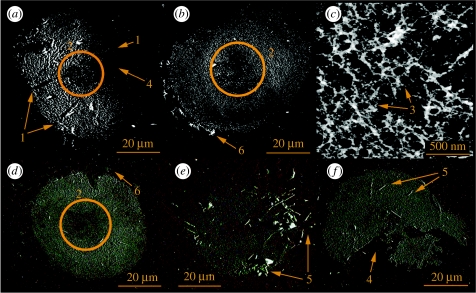Figure 2.
(a–f) AFMs of replicate S. balanoides footprints demonstrating a variety of traits, namely (1) the presence of sensory setae beneath the attachment disc during exploration is suggested by their negative imprints in the deposited material; (2) the centre of the attachment disc, where the axial sense organ is located, either does not secrete any footprint material or is never in direct contact with the surface; (3) the fibrillar/porous nature of the footprint material, perhaps resulting from the presence of cuticular villi in the adhesive deposit; (4) peeling of the footprint material from the surface; (5) bacteria associated with cyprid footprints and (6) the contact point of the cuticular velum that encircles the cyprid attachment disc.

